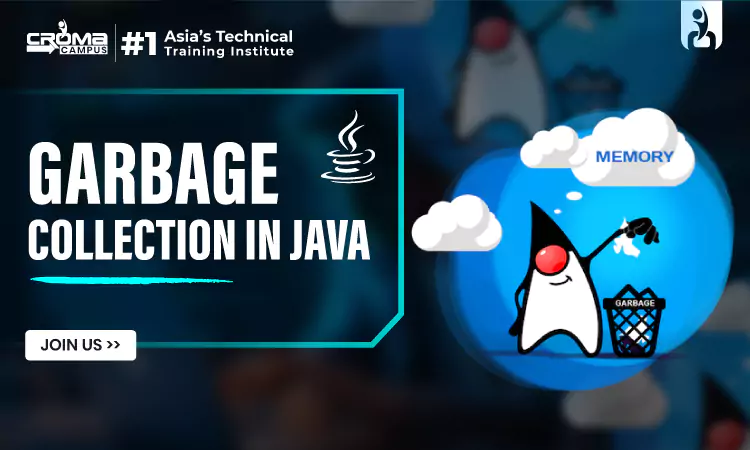What Is Garbage Collection In Java?
4.8 out of 5 based on 8749 votesLast updated on 28th Sep 2024 15.9K Views
- Bookmark

Garbage collection in Java automatically reclaims memory by removing objects that are no longer referenced, improving memory management and performance.

Introduction
In Java, Garbage Collection (GC) is an automatic memory management feature that helps efficiently manage the application’s memory. Garbage Collection in Java eliminates the need for developers to manually allocate and deallocate memory, which is common in other programming languages like C or C++. This process reclaims the memory occupied by objects no longer used by the application, allowing developers to focus on coding logic rather than memory management. Explore the syllabus, understanding how Garbage Collection works is critical for optimizing applications, particularly in enterprise environments where efficient memory management is essential. Java Full Stack developers must grasp how memory works under the hood to build robust, scalable applications.
Garbage Collection: Java
Java’s memory management model is based on the Java Virtual Machine (JVM), which dynamically allocates memory as needed by the program. This prevents memory leaks and optimizes the application’s performance.
How Does Garbage Collection Work in Java?
The JVM uses a memory area called the Heap to store objects created by a Java program. The heap is divided into two major sections:
- Young Generation: This area is for newly created objects. The Eden space is where objects are initially allocated, and if they survive garbage collection, they move to the Survivor Space.
- Old Generation: If objects persist long enough, they get moved to the Old Generation. The Old Generation area is for long-lived objects and is collected less frequently.
Mark-and-Sweep Algorithm
The most common technique employed by Java's garbage collectors is the Mark-and-Sweep Algorithm. Here’s how it works:
- Marking Phase: The algorithm traverses the object graph, marking objects that are still being referenced.
- Sweeping Phase: It sweeps through the memory, reclaiming the space occupied by unmarked objects.
Types of Garbage Collectors in Java
Java provides different types of garbage collectors, each with unique characteristics and use cases. Choosing the right garbage collector can have a significant impact on your application’s performance. The Java Full Stack Developer Training often includes practical sessions to help developers understand the different garbage collectors.
Serial Garbage Collector
- Use Case: Suitable for small applications with low memory footprint.
- How It Works: It performs garbage collection in a single thread, which can pause the application during collection.
Parallel Garbage Collector
- Use Case: Ideal for multi-threaded applications.
- How It Works: It uses multiple threads for garbage collection, which improves throughput but may cause longer pauses.
CMS (Concurrent Mark-Sweep) Garbage Collector
- Use Case: Designed for applications where response time is critical, such as real-time systems.
- How It Works: It reduces pause times by performing garbage collection concurrently with the application’s execution.
G1 (Garbage First) Garbage Collector
- Use Case: Suitable for applications with large heaps and low-latency requirements.
- How It Works: Divides the heap into regions and prioritizes garbage collection in regions with the most garbage.
Importance of Garbage Collection for Java Full Stack Developers
For a Java Full Stack Developer, understanding how garbage collection works is essential. Efficient memory management is a critical skill for full-stack developers, especially those working on applications that need to scale and handle large amounts of data. The garbage collector must be properly configured to avoid performance bottlenecks in production environments.
In the Java Full Stack Developer Syllabus, topics such as memory management and garbage collection are taught to ensure developers can optimize application performance. Mastery of these topics is necessary to build high-performance back-end systems, particularly when dealing with server-side applications that handle multiple requests concurrently.
Important Concepts
Understanding the key concepts related to Garbage Collection in Java is crucial for optimizing memory management in applications.
1. Unreachable Objects
Unreachable objects are objects in memory that are no longer referenced by any part of the program. When an object becomes unreachable, it can no longer be accessed or used by the program. Java’s garbage collector automatically identifies and reclaims memory occupied by these unreachable objects, ensuring efficient use of system resources.
2. Eligibility for Garbage Collection
An object becomes eligible for garbage collection when it is no longer accessible by any active thread in the application.
- When the object’s reference is set to null.
- When objects go out of scope, especially in method calls.
- If the object is part of a cyclic reference but not accessible by any thread.
3. Ways for Requesting JVM to Run the Garbage Collector
While Java automatically handles garbage collection, developers can suggest the JVM to run the garbage collector. However, this is merely a request, and the JVM may choose to ignore it. The two most common methods to request garbage collection are:
- gc(): This method hints to the JVM to start garbage collection.
- getRuntime().gc(): This is another way to request garbage collection via the Runtime object.
While developers can request garbage collection, it’s important to remember that it’s ultimately the JVM that decides when to run it.
Example of Beginner Code Without Understanding Garbage Collection
When beginners are not familiar with the Garbage Collector, they may code without considering memory management. Here's an example of how such a beginner might write code without optimizing for garbage collection:
public class Employee {
private String name;
private int id;
public Employee(String name, int id) {
this.name = name;
this.id = id;
}
public void displayDetails() {
System.out.println("Employee ID: " + id + ", Name: " + name);
}
public static void main(String[] args) {
// Creating objects in a loop
for (int i = 0; i < 100000; i++) {
Employee emp = new Employee("Employee" + i, i);
emp.displayDetails();
}
// Not explicitly handling unused objects
System.out.println("End of Program");
}
}
Issues with This Approach:
- Uncontrolled Object Creation: The code creates 100,000 Employee objects in a loop, and each object is displayed without any concern for memory management.
- Lack of Memory Awareness: Once an object is no longer used, the developer makes no effort to release the memory. As a result, large amounts of memory may be consumed, which could lead to performance issues or even an OutOfMemoryError in extreme cases.
- No Nulling of References: The beginner might not realize that once an object is no longer needed, setting its reference to null could make it eligible for garbage collection earlier.
Also Read This:
Java Full Stack Interview Questions
Full Stack Developer Course Online
Mern Stack Interview Questions
Correcting the Approach Using Garbage Collection Knowledge
By understanding garbage collection, developers can better manage memory. For instance:
- Optimizing Object Creation: Avoid creating unnecessary objects.
- Setting Unused Objects to Null: Help the garbage collector by making objects eligible for collection when they are no longer needed.
- Profiling Memory Usage: Use tools to monitor memory and understand how garbage collection impacts the application.
These adjustments lead to more efficient memory management in Java applications.
Trends in Java Garbage Collection for Modern Applications
As Java continues to evolve, garbage collection (GC) has become more sophisticated to meet the needs of modern applications. With the rise of cloud-native and microservices architectures, applications often need to handle large volumes of data with minimal latency. New garbage collectors such as G1GC (Garbage-First Garbage Collector) and ZGC (Z Garbage Collector) are designed for low-latency, high-throughput environments, optimizing pause times and improving scalability.
Another emerging trend is automatic memory tuning—tools that can dynamically adjust GC settings based on application behavior, reducing the need for manual intervention. Additionally, Concurrent Garbage Collection techniques have gained popularity, allowing for memory reclamation without significant application pauses, making Java a viable option for real-time systems.
These innovations in garbage collection ensure that Java remains competitive in handling large-scale, performance-critical applications across various industries. As applications become more resource-intensive, garbage collection will continue to adapt, ensuring efficient memory management.
In the Java Full Stack Developer Training, you will learn these skills and gain an in-depth understanding of how to optimize application performance, including memory management and garbage collection.
Skills for Java Full Stack Developers
Skill | Description |
Java Programming | Core Java, OOP, Exception Handling |
Spring Framework | Spring, Spring Boot for back-end development |
Database Management | SQL, NoSQL, and database optimization |
Version Control | Git, GitHub for version tracking |
Front-End Technologies | HTML, CSS, JavaScript, React, Angular |
DevOps Tools | Jenkins, Docker, and Kubernetes for CI/CD pipelines |
Performance Tuning for Garbage Collection in Java
Java provides several tools and techniques to monitor and optimize garbage collection, which can have a direct impact on application performance. Developers must know how to fine-tune garbage collection settings to meet the specific requirements of their applications.
- JVM Flags: Tuning the JVM with specific flags can optimize garbage collection behavior. For instance, -Xms and -Xmx can be used to set the initial and maximum heap size.
- Garbage Collection Logs: JVM options like -XX:+PrintGCDetails enable the logging of garbage collection events. Analyzing these logs helps in understanding how often garbage collection occurs and the amount of memory being reclaimed.
- VisualVM: A tool to monitor memory usage in real-time and track how garbage collection affects the performance of your application.
- HeapDump Analysis: Taking a heap dump allows developers to see all objects in the heap memory and detect memory leaks or inefficient object creation patterns.
By learning how to fine-tune garbage collection and implement best practices through the Java Full Stack Course Online, developers can avoid common memory pitfalls and ensure smooth application performance.
Best Practices for Java Garbage Collection
- Choose the Right Garbage Collector: Depending on the application’s requirements, choosing the correct garbage collector (e.g., CMS or G1) is crucial. CMS is best for low-latency systems, while G1 is designed for large heaps.
- Minimize Object Creation: Avoid unnecessary object creation by reusing objects where possible.
- Use Weak References: For cache-like structures, weak references can be used to prevent objects from being unnecessarily retained in memory.
- Monitor and Optimize: Regularly monitor garbage collection logs to identify potential performance bottlenecks. Use tools like VisualVM and heap dumps to track memory usage.
Conclusion
Garbage Collection in Java is a vital process that manages memory efficiently, allowing developers to focus on writing robust and scalable applications without worrying about manual memory deallocation. For a Java Developer, mastering garbage collection is essential for building high-performance applications, particularly in server-side development. Through Java Full Stack Training, developers can gain the skills needed to optimize memory management, making them valuable assets in any development team.
Subscribe For Free Demo
Free Demo for Corporate & Online Trainings.
Your email address will not be published. Required fields are marked *





















 Master in Cloud Computing Training
Master in Cloud Computing Training